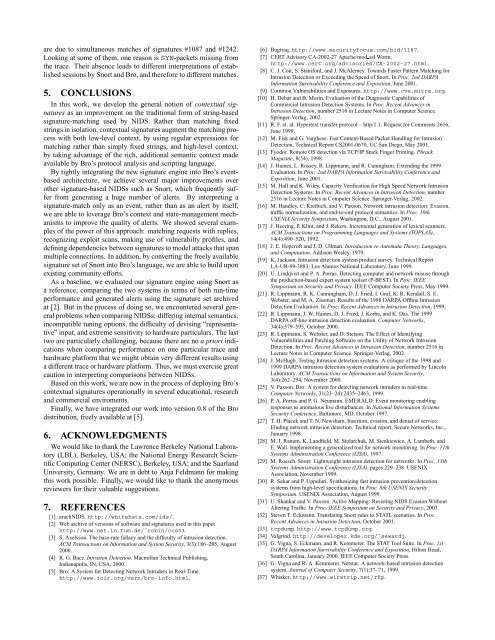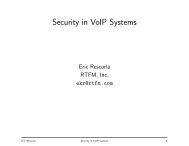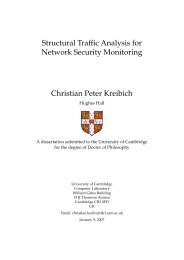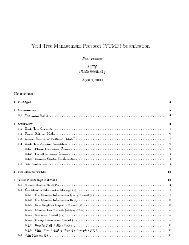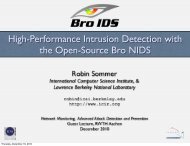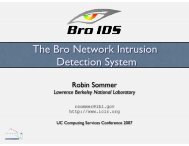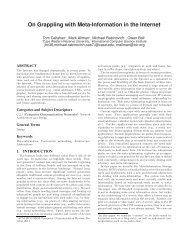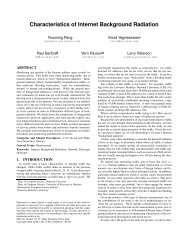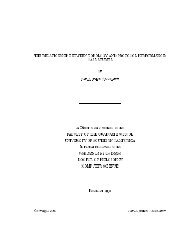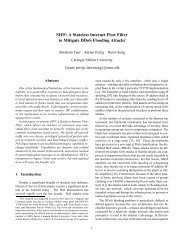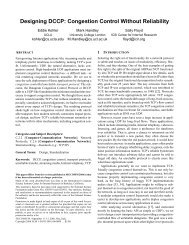Enhancing Byte-Level Network Intrusion Detection Signatures with ...
Enhancing Byte-Level Network Intrusion Detection Signatures with ...
Enhancing Byte-Level Network Intrusion Detection Signatures with ...
Create successful ePaper yourself
Turn your PDF publications into a flip-book with our unique Google optimized e-Paper software.
are due to simultaneous matches of signatures #1087 and #1242.<br />
Looking at some of them, one reason is SYN-packets missing from<br />
the trace. Their absence leads to different interpretations of established<br />
sessions by Snort and Bro, and therefore to different matches.<br />
5. CONCLUSIONS<br />
In this work, we develop the general notion of contextual signatures<br />
as an improvement on the traditional form of string-based<br />
signature-matching used by NIDS. Rather than matching fixed<br />
strings in isolation, contextual signatures augment the matching process<br />
<strong>with</strong> both low-level context, by using regular expressions for<br />
matching rather than simply fixed strings, and high-level context,<br />
by taking advantage of the rich, additional semantic context made<br />
available by Bro’s protocol analysis and scripting language.<br />
By tightly integrating the new signature engine into Bro’s eventbased<br />
architecture, we achieve several major improvements over<br />
other signature-based NIDSs such as Snort, which frequently suffer<br />
from generating a huge number of alerts. By interpreting a<br />
signature-match only as an event, rather than as an alert by itself,<br />
we are able to leverage Bro’s context and state-management mechanisms<br />
to improve the quality of alerts. We showed several examples<br />
of the power of this approach: matching requests <strong>with</strong> replies,<br />
recognizing exploit scans, making use of vulnerabilty profiles, and<br />
defining dependencies between signatures to model attacks that span<br />
multiple connections. In addition, by converting the freely available<br />
signature set of Snort into Bro’s language, we are able to build upon<br />
existing community efforts.<br />
As a baseline, we evaluated our signature engine using Snort as<br />
a reference, comparing the two systems in terms of both run-time<br />
performance and generated alerts using the signature set archived<br />
at [2]. But in the process of doing so, we encountered several general<br />
problems when comparing NIDSs: differing internal semantics,<br />
incompatible tuning options, the difficulty of devising “representative”<br />
input, and extreme sensitivity to hardware particulars. The last<br />
two are particularly challenging, because there are no a priori indications<br />
when comparing performance on one particular trace and<br />
hardware platform that we might obtain very different results using<br />
a different trace or hardware platform. Thus, we must exercise great<br />
caution in interpreting comparisons between NIDSs.<br />
Based on this work, we are now in the process of deploying Bro’s<br />
contextual signatures operationally in several educational, research<br />
and commercial enviroments.<br />
Finally, we have integrated our work into version 0.8 of the Bro<br />
distribution, freely available at [5].<br />
6. ACKNOWLEDGMENTS<br />
We would like to thank the Lawrence Berkeley National Laboratory<br />
(LBL), Berkeley, USA; the National Energy Research Scientific<br />
Computing Center (NERSC), Berkeley, USA; and the Saarland<br />
University, Germany. We are in debt to Anja Feldmann for making<br />
this work possible. Finally, we would like to thank the anonymous<br />
reviewers for their valuable suggestions.<br />
7. REFERENCES<br />
[1] arachNIDS. http://whitehats.com/ids/.<br />
[2] Web archive of versions of software and signatures used in this paper.<br />
http://www.net.in.tum.de/˜robin/ccs03.<br />
[3] S. Axelsson. The base-rate fallacy and the difficulty of intrusion detection.<br />
ACM Transactions on Information and System Security, 3(3):186–205, August<br />
2000.<br />
[4] R. G. Bace. <strong>Intrusion</strong> <strong>Detection</strong>. Macmillan Technical Publishing,<br />
Indianapolis, IN, USA, 2000.<br />
[5] Bro: A System for Detecting <strong>Network</strong> Intruders in Real-Time.<br />
http://www.icir.org/vern/bro-info.html.<br />
[6] Bugtraq. http://www.securityfocus.com/bid/1187.<br />
[7] CERT Advisory CA-2002-27 Apache/mod ssl Worm.<br />
http://www.cert.org/advisories/CA-2002-27.html.<br />
[8] C. J. Coit, S. Staniford, and J. McAlerney. Towards Faster Pattern Matching for<br />
<strong>Intrusion</strong> <strong>Detection</strong> or Exceeding the Speed of Snort. In Proc. 2nd DARPA<br />
Information Survivability Conference and Exposition, June 2001.<br />
[9] Common Vulnerabilities and Exposures. http://www.cve.mitre.org.<br />
[10] H. Debar and B. Morin. Evaluation of the Diagnostic Capabilities of<br />
Commercial <strong>Intrusion</strong> <strong>Detection</strong> Systems. In Proc. Recent Advances in<br />
<strong>Intrusion</strong> <strong>Detection</strong>, number 2516 in Lecture Notes in Computer Science.<br />
Springer-Verlag, 2002.<br />
[11] R. F. et. al. Hypertext transfer protocol – http/1.1. Request for Comments 2616,<br />
June 1999.<br />
[12] M. Fisk and G. Varghese. Fast Content-Based Packet Handling for <strong>Intrusion</strong><br />
<strong>Detection</strong>. Technical Report CS2001-0670, UC San Diego, May 2001.<br />
[13] Fyodor. Remote OS detection via TCP/IP Stack Finger Printing. Phrack<br />
Magazine, 8(54), 1998.<br />
[14] J. Haines, L. Rossey, R. Lippmann, and R. Cunnigham. Extending the 1999<br />
Evaluation. In Proc. 2nd DARPA Information Survivability Conference and<br />
Exposition, June 2001.<br />
[15] M. Hall and K. Wiley. Capacity Verification for High Speed <strong>Network</strong> <strong>Intrusion</strong><br />
<strong>Detection</strong> Systems. In Proc. Recent Advances in <strong>Intrusion</strong> <strong>Detection</strong>, number<br />
2516 in Lecture Notes in Computer Science. Springer-Verlag, 2002.<br />
[16] M. Handley, C. Kreibich, and V. Paxson. <strong>Network</strong> intrusion detection: Evasion,<br />
traffic normalization, and end-to-end protocol semantics. In Proc. 10th<br />
USENIX Security Symposium, Washington, D.C., August 2001.<br />
[17] J. Heering, P. Klint, and J. Rekers. Incremental generation of lexical scanners.<br />
ACM Transactions on Programming Languages and Systems (TOPLAS),<br />
14(4):490–520, 1992.<br />
[18] J. E. Hopcroft and J. D. Ullman. Introduction to Automata Theory, Languages,<br />
and Computation. Addison Wesley, 1979.<br />
[19] K. Jackson. <strong>Intrusion</strong> detection system product survey. Technical Report<br />
LA-UR-99-3883, Los Alamos National Laboratory, June 1999.<br />
[20] U. Lindqvist and P. A. Porras. Detecting computer and network misuse through<br />
the production-based expert system toolset (P-BEST). In Proc. IEEE<br />
Symposium on Security and Privacy. IEEE Computer Society Press, May 1999.<br />
[21] R. Lippmann, R. K. Cunningham, D. J. Fried, I. Graf, K. R. Kendall, S. E.<br />
Webster, and M. A. Zissman. Results of the 1998 DARPA Offline <strong>Intrusion</strong><br />
<strong>Detection</strong> Evaluation. In Proc. Recent Advances in <strong>Intrusion</strong> <strong>Detection</strong>, 1999.<br />
[22] R. Lippmann, J. W. Haines, D. J. Fried, J. Korba, and K. Das. The 1999<br />
DARPA off-line intrusion detection evaluation. Computer <strong>Network</strong>s,<br />
34(4):579–595, October 2000.<br />
[23] R. Lippmann, S. Webster, and D. Stetson. The Effect of Identifying<br />
Vulnerabilities and Patching Software on the Utility of <strong>Network</strong> <strong>Intrusion</strong><br />
<strong>Detection</strong>. In Proc. Recent Advances in <strong>Intrusion</strong> <strong>Detection</strong>, number 2516 in<br />
Lecture Notes in Computer Science. Springer-Verlag, 2002.<br />
[24] J. McHugh. Testing <strong>Intrusion</strong> detection systems: A critique of the 1998 and<br />
1999 DARPA intrusion detection system evaluations as performed by Lincoln<br />
Laboratory. ACM Transactions on Information and System Security,<br />
3(4):262–294, November 2000.<br />
[25] V. Paxson. Bro: A system for detecting network intruders in real-time.<br />
Computer <strong>Network</strong>s, 31(23–24):2435–2463, 1999.<br />
[26] P. A. Porras and P. G. Neumann. EMERALD: Event monitoring enabling<br />
responses to anomalous live disturbances. In National Information Systems<br />
Security Conference, Baltimore, MD, October 1997.<br />
[27] T. H. Ptacek and T. N. Newsham. Insertion, evasion, and denial of service:<br />
Eluding network intrusion detection. Technical report, Secure <strong>Network</strong>s, Inc.,<br />
January 1998.<br />
[28] M. J. Ranum, K. Landfield, M. Stolarchuk, M. Sienkiewicz, A. Lambeth, and<br />
E. Wall. Implementing a generalized tool for network monitoring. In Proc. 11th<br />
Systems Administration Conference (LISA), 1997.<br />
[29] M. Roesch. Snort: Lightweight intrusion detection for networks. In Proc. 13th<br />
Systems Administration Conference (LISA), pages 229–238. USENIX<br />
Association, November 1999.<br />
[30] R. Sekar and P. Uppuluri. Synthesizing fast intrusion prevention/detection<br />
systems from high-level specifications. In Proc. 8th USENIX Security<br />
Symposium. USENIX Association, August 1999.<br />
[31] U. Shankar and V. Paxson. Active Mapping: Resisting NIDS Evasion Without<br />
Altering Traffic. In Proc. IEEE Symposium on Security and Privacy, 2003.<br />
[32] Steven T. Eckmann. Translating Snort rules to STATL scenarios. In Proc.<br />
Recent Advances in <strong>Intrusion</strong> <strong>Detection</strong>, October 2001.<br />
[33] tcpdump. http://www.tcpdump.org.<br />
[34] Valgrind. http://developer.kde.org/˜sewardj.<br />
[35] G. Vigna, S. Eckmann, and R. Kemmerer. The STAT Tool Suite. In Proc. 1st<br />
DARPA Information Survivability Conference and Exposition, Hilton Head,<br />
South Carolina, January 2000. IEEE Computer Society Press.<br />
[36] G. Vigna and R. A. Kemmerer. Netstat: A network-based intrusion detection<br />
system. Journal of Computer Security, 7(1):37–71, 1999.<br />
[37] Whisker. http://www.wiretrip.net/rfp.


